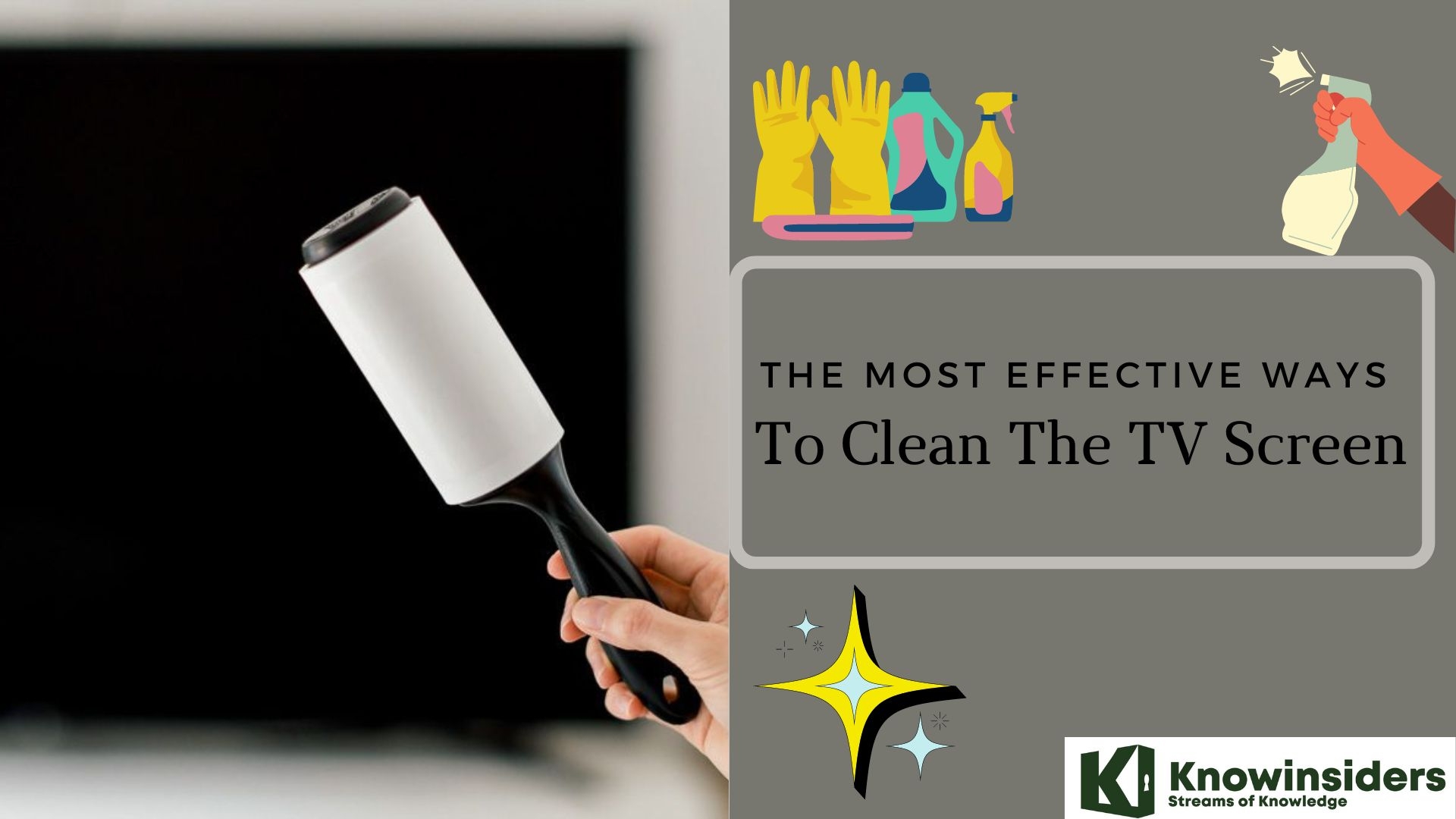How to Hold Chopsticks The Right Ways: The Simplest Guide
 |
| How to Hold Chopsticks The Right Ways: The Simplest Guide |
Chopsticks are probably one of the most versatile utensils ever. Think of them like a fork, knife and pair of tongs all wrapped up into one. You can pretty much use them to eat anything, sushi, ramen, rice, dumplings and veggies to name a few. But, if you’re over the age of 12 and still eating sushi with a fork, listen up. It’s time to finally master the art of chopsticks once and for all. Here are how you can use and hold the chopsticks the right ways.
What are chopsticks?
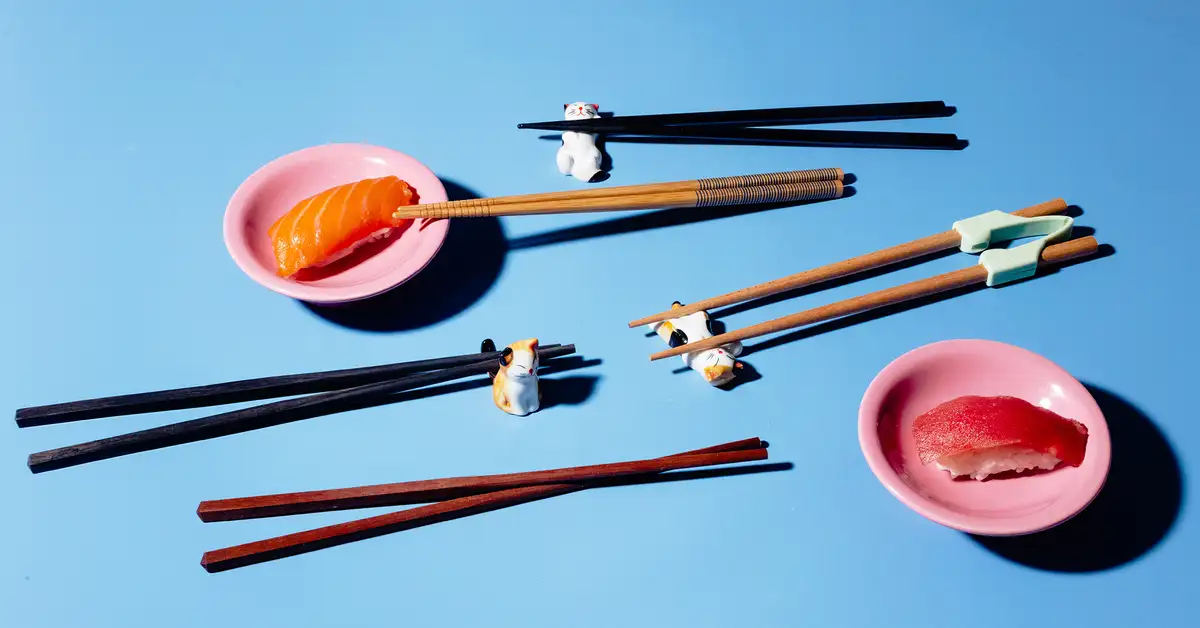 |
| Photo: NYTimes |
Chopsticks are shaped pairs of equal-length sticks of Chinese origin that have been used as kitchen and eating utensils in most of East Asia for over three millennia. They are held in the dominant hand, secured by fingers, and wielded as extensions of the hand, to pick up food.
First used by the Chinese, chopsticks later spread to other East Asian cultural sphere countries including Japan, Korea, and Vietnam. As ethnic Chinese emigrated, the use of chopsticks as eating utensils for certain ethnic food took hold in South and Southeast Asian countries such as Cambodia, Laos, Nepal, Myanmar, Singapore, and Thailand. In India (mainly in Himalayan region), Laos, Myanmar, Thailand, and Nepal, chopsticks are generally used to consume noodles. Similarly, chopsticks have become more accepted in connection with Asian food in Hawaii, the West Coast of North America, and cities with Overseas Asian communities across the world.
Chopsticks are smoothed, and frequently tapered. They are traditionally made of wood, bamboo, metal, ivory, and ceramics, and in modern days, increasingly available in non-traditional materials such as plastic, stainless steel, and even titanium. Chopsticks are often seen as requiring practice and skill to master to be used as an eating utensil.
A Brief History of Chopsticks
 |
| Photo: Duong's Restaurant |
The Chinese have been wielding chopsticks since at least 1200 B.C., and by A.D. 500 the slender batons had swept the Asian continent from Vietnam to Japan. From their humble beginnings as cooking utensils to paper-wrapped bamboo sets at the sushi counter, there’s more to chopsticks than meets the eye.
The fabled ruins of Yin, in Henan province, provided not only the earliest examples of Chinese writing but also the first known chopsticks—bronze sets found in tombs at the site. Capable of reaching deep into boiling pots of water or oil, early chopsticks were used mainly for cooking. It wasn’t until A.D. 400 that people began eating with the utensils. This happened when a population boom across China sapped resources and forced cooks to develop cost-saving habits. They began chopping food into smaller pieces that required less cooking fuel—and happened to be perfect for the tweezers-like grip of chopsticks.
As food became bite-sized, knives became more or less obsolete. Their decline—and chopsticks’ ascent—also came courtesy of Confucius. As a vegetarian, he believed that sharp utensils at the dinner table would remind eaters of the slaughterhouse. He also thought that knives’ sharp points evoked violence and warfare, killing the happy, contended mood that should reign during meals. Thanks in part to his teachings, chopstick use quickly became widespread throughout Asia.
Different cultures adopted different chopstick styles. Perhaps in a nod to Confucius, Chinese chopsticks featured a blunt rather than pointed end. In Japan, chopsticks were 8 inches long for men and 7 inches long for women. In 1878 the Japanese became the first to create the now-ubiquitous disposable set, typically made of bamboo or wood. Wealthy diners could eat with ivory, jade, coral, brass or agate versions, while the most privileged used silver sets. It was believed that the silver would corrode and turn black if it came into contact with poisoned food.
Throughout history, chopsticks have enjoyed a symbiotic relationship with another staple of Asian cuisine: rice. Naturally, eating with chopsticks lends itself to some types of food more than others. At first glance, you’d think that rice wouldn’t make the cut, but in Asia most rice is of the short- or medium-grain variety. The starches in these rices create a cooked product that is tender and chewy, unlike the fluffy and distinct grains of Western long-grain rice. As chopsticks come together to lift steaming bundles of sticky rice, it’s a match made in heaven.
Video guide on how to use chopsticks the right way
What are the different types of chopsticks?
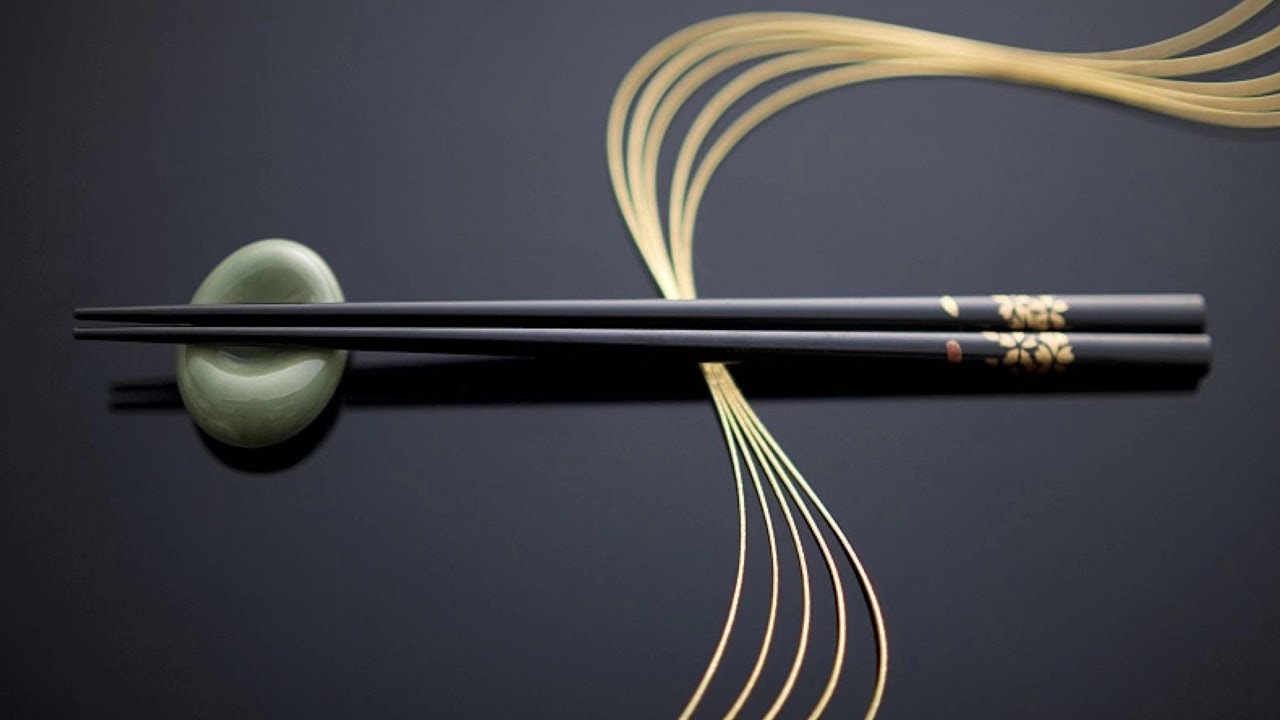 |
| Photo: CGTN |
- Carbonized bamboo chopsticks: Made from carbonized bamboo, these types of chopsticks can be printed with a variety of patterns. The carbonized process darkens the color of the natural bamboo and also makes the chopsticks more durable.
- Bamboo chopsticks: Bamboo is the most common material used for chopsticks because it is a fast-growing resource that is naturally strong and eco-friendly. Bamboo chopsticks are non-toxic and an affordable option for commercial use.
- Chopsticks with wide ends: Wide, blunt ends make it easier to pick up sushi rolls, noodles, and rice. These types of chopsticks are commonly found in China and have become widely used around the world.
- Tapered chopsticks with pointed ends: The tapered ends of chopsticks create a narrow point to easily pick up fish bones, scales, and other small things found in Asian food. These chopsticks are commonly used in Japanese culture.
- Dual-purpose chopsticks and utensils: These types of chopsticks are not native to Asian culture and have been created by Western influence. Dual-ended chopsticks include one end with a traditional point and the other end with either a fork, spoon, or another utensil.
- Chopsticks with twisted contours: Chopsticks with twisted contours provide a more secure hand grip to prevent slipping. Some chopsticks include grooved rings around the tip to easily pick up delicate foods.
- Reusable chopsticks: An alternative to disposable chopsticks, some chopsticks are made from plastic, stainless steel, or melamine. These materials are durable and easy to clean for those interested in a reusable option.
The Right Way To Use Chopsticks, according to Mashed
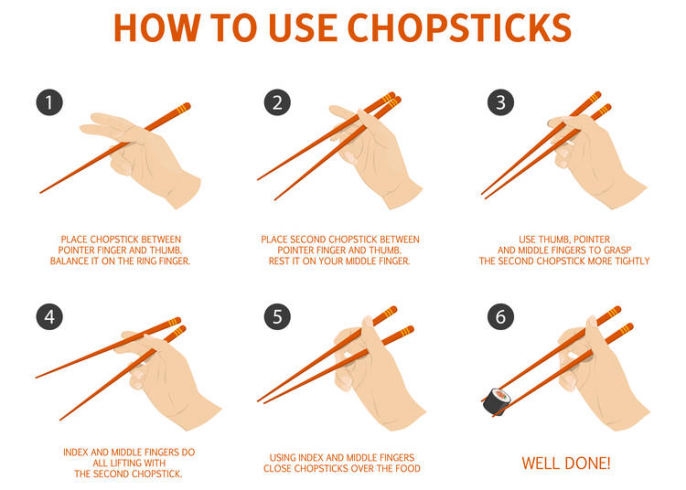 |
| Photo: Live Japan |
Some Westerners are reluctant to use chopsticks due to a perceived difficulty. This is silly. They aren't difficult, but you do need to get used to them. While you can hold your chopsticks however you like, there is a proper way of holding them which thousands of years of use suggests is the easiest and most elegant. (You'll want to follow along in the picture above.) You hold one chopstick in your dominant hand between your pointer, middle finger, and thumb, and when you move it up and down, your thumb should be stationary. You can practice with a single chopstick to get this right. The other chopstick goes between your thumb and your palm, rests on your ring finger, and stays still.
And that's it! It might look difficult, but it's just one of those things: like riding a bike, rolling your R's, or opening a beer bottle with another beer bottle: you get better with practice. To be fair, while this is considered the proper way to hold chopsticks, a large number of people who eat with chopsticks regularly just do it however it feels right to them. According to a Meijiro University study in 2012, only 30 percent of Japanese people aged from their 40s to their 50s actually held their chopsticks in the proper way. In Singapore, it is apparently common for people to rest the ends of the chopsticks between the thumb and forefinger and manipulate the top chopstick with the middle and forefinger alone. This is considered a more awkward position, but it clearly works for them.
So if you already have a satisfactory way of using chopsticks, you can get away with it even though witnesses might occasionally shake their heads at you. But if you're a complete chopstick novice, you're probably better off learning the standard position. You need to know the rules before you can break them!
1. Start with one chopstick
Rest the first chopstick on the base of your thumb while holding it between your middle and ring fingers.
2. Add a second chopstick
Take the second chopstick and hold it like a pencil, about one-third of the way from its top. It should feel somewhat comfortable. Something to note is that this second chopstick should be pointing the same way as the first chopstick.
3. Master the movement
Finally, move the upper chopstick with your thumb, index and middle fingers simultaneously. When grabbing food, make sure it’s between the lower and upper chopsticks. They key is that the bottom chopstick remains still while only the upper chopstick moves.
4. Get ready to grab
Pick up everything (rice, vegetables and even gummi bears), and never look back.
Of course, we have to recommend that you practice practice practice. In no time you’ll be using them like a pro. Sushi for dinner tonight, anyone?
Usage rules of thumb
While there are differences in chopstick etiquette across cultures, there are also some common blunders. It is generally considered rude to impale food with chopsticks, though people do it sometimes. (You might as well eat with toothpicks, but whatever.) Chopsticks should not be used to move bowls and plates around either, because you have hands for a reason. One of the most important taboos is never to stick your chopsticks upright in your rice at the table. This resembles incense sticks burned to venerate deceased loved ones, and thus is seen as a harbinger of death. This taboo is common across chopstick-using cultures, as reminding people of their impending mortality at the dinner table is gauche at best wherever you are.
It should go without saying you shouldn't play with your chopsticks. Don't use them as drumsticks. Don't bang on your bowl and demand immediate sustenance. Don't gesticulate wildly with them. Don't stick them in your mouth and pretend to be a walrus or a vampire with absurdly long fangs. None of that. Have I done all of these things? Well, yes, but you're better than that.
Chopstick rests
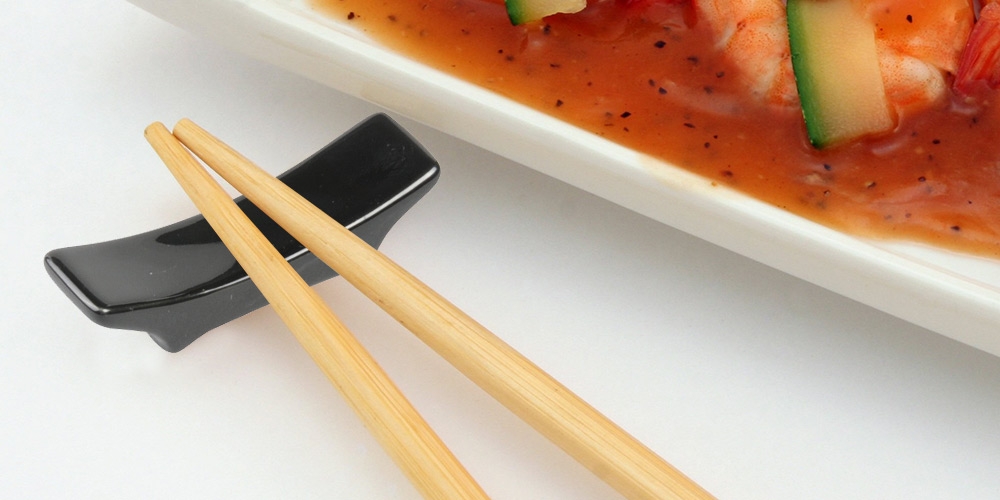 |
| Photo: Shutterstock |
In Japanese etiquette it's considered improper to lay your chopsticks across your bowl at the end of the meal. You might be forgiven for wondering what on Earth you should do with them. Fear not! Japanese restaurants that expect you to eat this elegantly will provide a hashioki, a chopstick rest. Originally developed in the Heian period as an earthernware holder to keep chopsticks warm during state banquets, they've since been refined to keep chopsticks clean and show off one's refinement to guests.
Even some disposable chopstick makers have planned for this. In 2016, Twitter user Trash Panda realized the chunk of wood at the end of some disposable chopsticks could be snapped off to serve as a makeshift hashioki, which caused a surprisingly large segment of social media to collectively exclaim, "Oh, what? Of course! I'm an idiot for not realizing." If your disposable chopsticks don't have the bit at the end, you can always roll up the paper sleeve the chopsticks come in to fashion a makeshift chopstick rest.
 Simple Tips to Change Your IP Address on iOS, Windows, Chrome and More Simple Tips to Change Your IP Address on iOS, Windows, Chrome and More Changing IP addresses can be difficult with some people who are new to computers or phones, but it will be made easier with this guide ... |
 Simple Tips to Change and Install Fonts in Windows 11 Simple Tips to Change and Install Fonts in Windows 11 Changing the default font on Windows 11 PC can be difficult, but here is how to do it with the simplest guides. |
 Top 15+ Best FREE Sites to Watch MLB Games Online Top 15+ Best FREE Sites to Watch MLB Games Online We rounded up websites that offer free live sports streams to watch MLB online. Here's what you need to know top 15 best free sites ... |
 How to Write A Long Essay on A Political Science Topic How to Write A Long Essay on A Political Science Topic Writing assignments are among the most challenging for many students, especially essays on vast and complicated topics requiring research and skills. |



